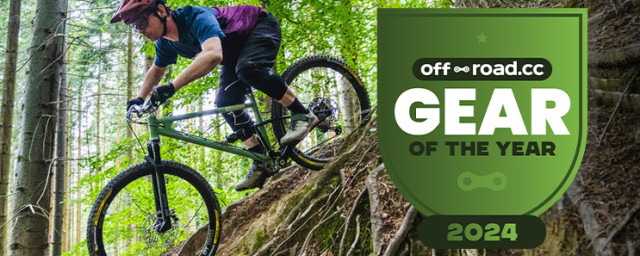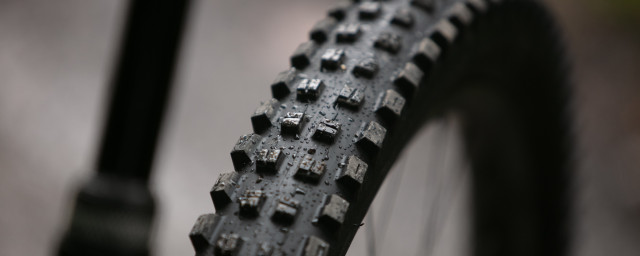- Smooth and silent motor
- App control is clever
- Clean integration
- Battery life not class-leading
- Fork is underwhelming
The Specialized Turbo Levo Hardtail Comp 6Fattie is a really interesting trail hardtail. With a super-quiet, smooth transmission and an integrated battery it looks and feels a lot like a non-powered hardtail, and it will appeal to people who want a bit of assistance in their riding without buying into the e-bike look. The app-based control is interesting too, and the whole experience feels very stripped back: no displays, not much changing of modes, just going out and riding.
“The Turbo Levo Hardtail Comp 6Fattie has all of the speed and nimble handling that our hardtail trail bikes are known for—only with a sophisticated Turbo boost”, say Specialized. “Then comes the efficient and powerful Turbo technology, mating the battery and motor into the M5 frame in a new way”.
The Specialized approach to the whole e-MTB business is a bit different. Bosch is the motor system that predominates, and that generally means an external battery, a nice clear display and a high quality motor unit bolted on. Some manufacturers are beginning to work harder to integrate the Bosch system, with some (such as Moustache) hiding the battery in a redesigned down tube, and others (eg Cube) customising the motor housing to blend in with the frame.
The Specialized Turbo Levo bikes have had integration as a key point from the starting gun, though. So much so that at first glance you might miss the electics in this hardtail. The 460Wh battery is fully integrated into the bottom of the down tube (it can be removed, of course) and the motor built into the frame as seamlessly as possible. The motor in question is by Brose, but it's a custom configuration for Specialized so it's not quite the same as a stock motor. What is the same is the quiet operation, though, thanks to the belt drive internals.
Also, there's no display. You can check the battery charge, and change modes, using a button and LED display on the down tube, but the Turbo Levo is primarily designed to hook up with a smartphone app. Once you've paired your bike to your phone you gain access to the bike's configuration, so you can adjust the assistance levels to suit your riding: if you're planning a long ride you can knock the Eco settting right back, for example, to give you a bigger range.
That's not all the app can do: in Smart Control mode you can set either how far you want to ride, or for how long, and the bike and app will take care of the battery management to get you back to the start with some juice left.
Specialized call this bike a fattie but in reality it's a 27.5+ bike; although the Specialized Ground Control and Purgatory three-inch tyres are on the edge of fat bike territory it's still a standard frame and fork, albeit using the plus-friendly Boost axle standard that's a bit wider for extra wheel stiffness. The Specialized M5 alloy frame is mated with a Rock Shox Reba RL fork. It's a 120mm travel unit on our XL test bike; smaller sizes get 100mm of front-end travel.
Transmission-wise you get a 10-speed SRAM GX setup, with an 11-40T cassette for a wide range of ratios. SRAM also supply the DB5 disc brakes with beefy 200mm rotors. You get a TranzX dropper seatpost with remote for the gnarly bits and Specialized Body Geometry saddle and grips. Our XL review bike weighs in at 21.9kg. We'll be putting it through its paces over the next few weeks.
The Turbo Levo is probably the bike that behaves most like a non-powered trail bike, of all the electric mountain bikes I've ridden. Mostly that's due to the way the motor works, its near-silent operation and the lack of any visual cues that you're riding an electric bike. When you're on a Bosch-powered bike with mode control easy to hand you tend to spend a lot of time looking at the display, and switching up and down. The Specialized I found i rode much more like a non-powered bike: turn it on at the start, go and ride, turn it off at the end. On a 1-2 hour loop, in the middle assistance mode, you're not going to run out of battery and you're not going to find anything you can't reasonably conquer.
The Turbo Levo handles well on a variety of trails. The Purgatory 3" tyres are at the big end of Plus, and almost tipping over into fat: most bikes are running 2.6" to 2.8" rubber. They're good and grippy on the climbs but can feel a bit squirmy when they bite on a flat corner; they're far from being the only plus tyres that do that, though. Once they do lose grip the bike's weight tends to keep things going sideways.
The frame and fork both use the wider Boost axle spacing and everything felt nice and laterally stiff. The Rockshox Reba SL fork can be made to exhibit a bit of fore-aft flex but it's generally well-behaved and runs through its travel predictably. The bike would probably benefit from something with slightly wider stanchions to shore up the front end a touch, though.
SRAM's GX 10-speed drivetrain isn't exactly top-dollar and the shifts feel a bit industrial at times, but all the groupsets from all the major players work incredibly well a long way down the range these days, and GX is no exception. The internally-routed TranzX dropper seatpost is another value rather than premium component, but I had no issues with it at all. The SRAM DB5 brakes with their 200mm rotors had plenty of stopping power for the bike's heft.
The motor in the Turbo Levo is made by Brose but it's custom-tuned and plugged into Specialized's own-spec battery and control system. The Brose is the quietest of the mid-motors and when you're out enjoying nature it's refreshing, after a lot of recent rides on Bosch bikes, to have no motor noise to distract you. The motor applies power smoothly and instantly, and it's more tuned to react to your input than the Bosch motor which is more heavily weighted towards cadence. Which suits you will depend on what you're after: the Specialized system makes you do a bit more work but it rewards you with a more natural ride feel. Even in the highest assistance mode you never feel like a passenger, and when you're tackling technical terrain you can use a high power mode in the knowledge that it's easier to finesse the assistance than it is with a Bosch bike.
The flip side of that coin is that the top-end power of the system is a bit less than the Bosch. It was noticeable when riding with friends on Bosch e-bikes that with everyone in top mode it took extra effort aboard the Specialized to stay in the group. Coming on to the power the Brose is excellent; when you're easing off it does have a tendency to clunk at times, and if you're surfing the 16mph assistance limit it's not the best system at easing the power in and out.
The Turbo Levo doesn't have a display unit on the bars. There's a button on the 460Wh integrated battery to turn the system on and off, and two other buttons to go up and down the modes. Around the buttons is a ring of 10 LEDs: these give you the current battery state and when you change assistance mode they'll give you a visual indication of which one you're in.
That's not the limit of the bike's control options, though. The Turbo Levo can link via Bluetooth to your smartphone, and the Mission Control app gives you access to the bike's motor system. You can fine-tune the motor characteristics to suit your riding, or you can plan and navigate a route with turn-by-turn directions; that's more for the road, though.
Most interesting is Smart Control: Tell the bike how long you want to ride for, or how far, and the app will manage the motor output to preserve the battery. It works pretty well and it takes away some of your range anxiety, although to be honest it's doing the same job that you subconsciously do on a bike where it's simple to switch modes: tailoring the assistance to the length of the ride.
The app is generally pretty good, and it can keep track of motor and battery information and charge cycles. If you have a newer Garmin with Connect IQ you can also use that to connect to the bike via ANT+, and change modes and view bike data from the Garmin.
Battery life from the 460Wh integrated battery is good, but not best in class. If you're sensible with the assistance modes you can easily ride for 2-3 hours over varied terrain, and that's enough range for most rides. Ridden back-to-back against a Bosch bike at Bike Park Wales the Specialized gave out first: the Bosch bike had a 500Wh battery so you'd expect a bit more range from it, but in reality the difference between the two was a bit bigger than the discrepancy in battery size would account for. You can charge the battery in situ or easily drop it out (it's held in with a through-axle) to charge it indoors. The design of the Turbo Levo means that there's no rattling of the battery, which we've experienced with other bikes (especially Bosch bikes with a frame-mounted battery). In fact the Specialized is just a quiet bike generally, until you hit the tarmac where the buzz of the big tyres does a better job than a bell ever would.
My overall impression of the Turbo Levo Hardtail Comp 6Fattie is that it's a very well-rounded bike with a good power system and a stable and neutral presence on the trails. It's a bit different to a Bosch bike both in terms of the way power is applied and the way you use it. The simple turn-it-on-and-ride aesthetic may appeal to you, as may the ability to control and tweak the bike from the app. If you're happy for an e-bike to look like an e-bike and you're after maximum assistance and range from your system, the Specialized isn't top of the pile, but it still has plenty in its locker.


































1 comments
Hi Dave - I'm looking for some recommendation, and I hope you can help me. I am looking for a 29" hardtail e-bike with Brose TF or TQ 120S - both as speed pedelecs. I will use the bike for commuting on tarmac and on normal wide gravel roads in the woods. The above Specialized is a cool bike, but I would like a bike with a Brose TF stock motor and not a custom-tuned one(and this is not even a TF). I like the look of it and the no-nonsense setup. The reason why I prefer Brose is that it is the most siIent motor I have tried. Bosch Performance Speed is super nice, but leaves a high noice. I have looked at M1 Sporttechnik Das Zell CC but that one you cannot remove the battery and its only 27". I would also like a 48V 630W or even larger battery. The new Haibike Flyon for 2019 may be a good choise. Can you recommend something ? it looks like 2019 is going to be a big year for e-bikes. Thank you. Best regards Henrik